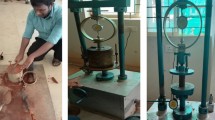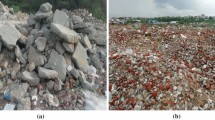Abstract
The effect of quarry dust based geopolymer cement (QDbGPC) and crushed waste glasses (CWG) on the triaxial and density characteristics of expansive test soil was investigated under laboratory conditions. Quarry dust is a solid waste the management of which poses a big problem to construction and environmental experts. So also is the management of waste glasses. Then again, the use conventional cement poses everyday threat to the environment as its utilization releases huge amount of CO2 to the environment thereby causing increased global warming. However, the utilization of quarry dust in the synthesis of geopolymer cements which is an eco-friendly geomaterial and by extension its use in the soil treatment protocol is the aim of this work. The test soil was observed to be a poorly graded A-2-6 soil according to USCS and AASHTO classification systems respectively. The treatment exercise showed that the shear characteristics of the treated soil improved consistently. The poisson ratio, porosity and submerged density improved with increased additives. The stress-strain relationship improved to a very stiff consistency which satisfies the requirements for subgrade and subbase materials in pavement construction. Finally, the utilization of QDbGPC proved to be a good replacement for conventional cement in terms of environmental issues resulting from CO2 emission, resistant to moisture, heat, sulphate attacks, etc on hydraulically bound materials.
Similar content being viewed by others
References
American Administration for State Highway Officials, Guide for Design of Pavement Structures, California, USA, 1993.
T.F. Fwa, The handbook of highway engineering, Tailor and Francis, New York, 2006.
M. D. Gidigasu, J. L. K. Dogbey, Geotechnical Characterization of Laterized Decomposed Rocks for Pavement Construction in Dry Sub-humid Environment, 6th South East Asian Conference on Soil Engineering, Taipei. 1 (1980) 493–506.
M. D. Olawale, Syntheses, characterization and Binding Strength of Geopolymers; a review, International Journal of Material Science and Alications 2(6) (2013) 185–193.
K. C. Onyelowe, Nanosized Palm Bunch Ash Stabilization of Lateritic Soils for Construction Purposes. International Journal of Geotechnical Engineering, 13(1) (2017) 83–91.
K. C. Onyelowe, Nanostructured Waste Paper Ash Treated Lateritic Soil and Its California Bearing Ratio Optimization. Global J Technol Optim 8 (2017b) 220.
K. C. Onyelowe, “Nanostructured Waste Paper Ash Stabilization of Lateritic Soils for Pavement Base Construction Purposes”. Electronic J. Geotechnical Eng. 22(09) (2017) 3633–3647.
K. C. Onyelowe, B. V. Duc, Durability of nanostructured biomasses ash (NBA) stabilized expansive soils for pavement foundation, International J. Geotechnical Eng. (2018). DOI: https://doi.org/10.1080/19386362.2017.1422909 [Online].
K. C. Onyelowe, B. V. Duc, Predicting Subgrade Stiffness of Nanostructured Palm Bunch Ash Stabilized Lateritic Soil for Transport Geotechnics Purposes. Journal of GeoEngineering of Taiwan Geotechnical Society 13(2) (2018) 59–67.
K. J. Osinubi, Laboratory Trial of Soil Stabilization of Nigerian Black Cotton Soil. Nigerian Society of Engineers Technical Transactions 35(4) (2000) 13–21.
M. Muthukumar, S. K. Sekar, S. K. Shukla, Swelling and Shrinkage Behaviour of Expansive Soil Blended with Lime and Fibres. Advances in Reinforced Soil Structures, Sustainable Civil Infrastructures (2018) 41–48.
O. Masaki, Ō. Eiji, Carbon blacks as the source materials for carbon nanotechnology. Carbon Nanotechnol 6 (2006) 127–151.
K. J. Osinubi, V. Bafyau, A. O. Eberemu, Bagasse ash stabilization of lateritic soil, Springer Link Sciences and Business Media (2009) 271–280.
C. Phetchuay, S Horpibulsuk, A Suksiripattanapong, C. Arulrajah, A. Udomchai, Strength development in soft marine clay stabilized by fly ash and calcium carbide residue based geopolymer. Alied Clay Science 127 (2016) 134–142.
C. Phetchuay, Horpibulsuk, S. Suksiripattanapong, C. Chinkulkijniwat, A Arulrajah, A and Disfani, M. M. Calcium carbide residue: Alkaline activator for clay-fly ash geopolymer. Constr. Build. Mater. 69 (2014) 285–294.
A. S. A. Rashid, N. Latifi, C. L. Meehan, K. N. Manahiloh, Sustainable improvement of tropical residual soil using an environmentally friendly additive. Geotech. Geolog. Eng. 35(6) (2017) 2613–2623.
S. L. Shen, Z. F. Wang, S. Horpibulsuk, and Kim, Y. H. Jet-Grouting with a newly developed technology: The Twin-Jet Method, Eng. Geology 152(1) (2013a) 87–95.
S. L. Shen, Z. F. Wang, J. Yang, C. E. Ho, Generalized aroach for prediction of jet grout column diameter, Journal of Geotechnical and Geoenvironmental Engineering, 139(12) (2013) 2060–2069. doi: https://doi.org/10.1061/(ASCE)GT.1943-5606.0000932
F. Skvara, T. Jilek, L. Kopecky, Geopolymer Materials Based on Fly Ash. Ceramics-Silikaty 46(3) (2005) 195–204.
G. N. Smith, I. G. N. Smith, Elements of Soil Mechanics, 7th Ed. Blackwell Science UK, 1998.
P. Sukmak, S. Horpibulsuk, S. L. Shen, P. Chindaprasirt, C. Suksiripattanapong, Factors influencing strength development in clay-fly ash geopolymer. Constr. Build. Mater. 47 (2013) 1125–1136.
N. Latifi, F. Vahedifard, E. Ghazanfari, A. S. A. Rashid, Sustainable Usage of Calcium Carbide Residue for Stabilization of Clays. J. Mater. Civ. Eng. 30(6) (2018).
N. Latifi, F. Vahedifard, E. Ghazanfari, S. Horpibulsuk, A. Marto, J. Williams, Sustainable improvement of clays using low-carbon non-traditional additive. International Journal of Geomechanics 18(3) (2017) 04017162.
N. Latifi, A. Eisazadeh, A. Marto, C. L. Meehan, Tropical residual soil stabilization: A powder form material for increasing soil strength. Constr. Build. Mater. 147 (2017) 827–836.
A. Nikolov, I. Rostovsky, H. Nugteren, Geopolymer Materials Based on Natural Zeolite. Case Studies in Construction Materials 6 (2017) 198–205.
E. Pimentel, Existing Methods for Swelling Test-a critical review. European Geosciences Union General Assembly 2015, EGU Division Energy, Resources and Environment, ERE, Energy Procedia 76 (2015) 96–105.
S. L. Shen, Z. F. Wang, W. C. Cheng, Estimation of lateral displacement induced byjet grouting in clayey soils, Geotechnique, ICE 67(7) (2017) 621–630.
K. Srinivasan, A. Sivakumar, Geopolymer Binders: A Need for Future Concrete Construction. ISRN Polymer Sciences (2013).
C. Suksiripattanapong, T. Srijumpa, S. Horpibulsuk, P. Sukmak, A. Arulrajah, Compressive strengths of water treatment sludge-fly ash geopolymer at various compression energies. Lowland Technology International 17(3) (2015) 147–156.
M. Hoy, S. Horpibulsuk, R. Rachan, A. Chinkulkijniwat, A. Arulrajah, Recycled asphalt pavement-fly ash geopolymers as a sustainable pavement base material: Strength and toxic leaching investigations. Science of the Total Environment 573 (2016) 19–26.
P. Ghosh, H. Kumar, B. Krishanu, Fly ash and kaolinite-based geopolymers: processing and assessment of some geotechnical properties. Inter. J. Geotechnical Eng. 10(4) (2016) 377–386.
R. M. Hamidi, Z. Man, K. A. Azizli, Concentration of NaOH and the Effect on the Properties of Fly Ash Based Geopolymer. 4th International Conference of Process Engineering and Advanced Materials; Procedia Engineering 148 (2016) 189–193.
Z. Hariz, A. M. M. Al-Bakri, H. Kamarudin, A. Nurliyana, B. Ridho, Review of Various Types of Geopolymer Materials with the Environmental Impact Assessment. MATEC Web of Conferences 97 (2017) 10–21.
K. Kayabali, S. Demir, Measurement of Swelling Pressure: Direct Method versus Indirect Methods. Can. Geotech. J. 48 (2011) 354–364.
N.J. Meegoda, P. Ratanweera, Compressibility of contaminated fine grained soil. Geotech Testing Journal ASTM 17 (1994) 101–112.
A. Tabarsa, N. Latifi, C. L. Meehan, K. N. Manahiloh, Laboratory investigation and field evaluation of loess improvement using nanoclay-A sustainable material for construction. Constr. Build. Mater. 158 (2018) 454–463.
W. Fedrigo, W. P. Nunez, T. R. Kleinert, M. F. Matuella, J. A. P. Ceratti, Strength, Shrinkage, Erodibility and Capillary Flow Characteritics of Cement-treated Recycled Pavement Materials. Inter. J. Pave. Res. Tech. 10 (2017) 393–402.
J. Davidovits, Geopolymer cement a review. InstitutGeopolymere, F-02100 Saint-Quentin, France. [Online], 2013.
R. Gopal, A.S.R. Rao, Basic and alied soil mechanics, 2nd Ed New Age Int’l Publishers, New Delhi, 2011.
F. Yang, Y. Li, Synthesis and alication of nanocarbon materials using plasma technology. Int. J. Chem. Eng. Al 6(1) (2015) 49–52.
Y. Bao, L. Zhan, C. Wang, Y. Wang, G. Yang, J. Yang, W. Qiao, L. Ling, Synthesis of carbon nanofiber/carbon foam composite for catalyst suort in gas phase catalytic reactions, New Carbon Mater. 26(5) (2011) 341–346.
L. Bromley, D. Hadfield, Geotechnical Asset Management: How Structural Engineers can exploit Geopolymer Injection Technology. URETEK Technical Report. [online], 2017.
Nigeria General Specification/Federal Ministry of Works and Housing. Testing for the selection of soil for roads and bridges, II 1997 391.
S. Rafat, I. K. Mohammad, Sulementary Cementing Materials. Springer, NY, 2011.
American Standard for Testing and Materials, Standard Specification for Pozzolan, ASTM C618, ASTM, West Conshohocken, 2014.
M. Anamika, C. Sanjukta, M. R. Prashant, W. Geeta, Evidence based green synthesis of nanoparticles. Adv. Mat. Lett 3(6) (2012) 519–525.
A. Arulrajah, T. A. Kua, S. Horpibulsuk, C. Phetchuay, C. Suksiripattanapong, Y. J. Du, Strength and microstructure evaluation of recycled glass-fly ash geopolymer as low-carbon masonry units. Constr. Build. Mater. 114 (2016) 400–406.
H. Akbari, R. Mensah-Biney, J. Simms, Production of Geopolymer Binder from Coal Fly Ash to Make Cementless Concrete. World of Coal Ash (WOCA) Conference in Nasvhille, TN-May 5–7 [Online], 2015.
O. Arioz, M. Tuncan, E. Arioz, K. Kilinc, Geopolymer: A New Generation Construction Material. 31st Conference on Our World in Concrete and Strucures: 16–17 August, Singapore [online], 2006.
Y. B. Acar, I. Olivieri, Pore fluid effects on the fabric and hydraulic conductivity of laboratory compacted clay. Transp. Res. Rec. 199 (1990) 144–159.
H. A. Abdel-Gawwad, S. A. Abo-El-Enem, A Novel Method to Produce Dry Polymer Cement Powder. HBRC Journal 12 (2016) 13–24.
BS 1377-2 Methods of Testing Soils for Civil Engineering Purposes, British Standard Institute, London, 1990.
BS 1377–7 Methods of Testing Soils for Civil Engineering Purposes; Shear Strength Test (Total Stress), British Standard Institute, London, 1990.
BS 1377-8 Methods of Testing Soils for Civil Engineering Purposes; Shear Strength Test (Cell and Effective Stress), British Standard Institute, London, 1990.
BS 1924 Methods of Tests for Stabilized Soil, British Standard Institute, London, 1990.
BS 5930 Methods of Soil Description, British Standard Institute, London, 2015.
Author information
Authors and Affiliations
Corresponding author
Rights and permissions
About this article
Cite this article
Onyelowe, K., Igboayaka, C., Orji, F. et al. Triaxial and density behaviour of quarry dust based geopolymer cement treated expansive soil with crushed waste glasses for pavement foundation purposes. Int. J. Pavement Res. Technol. 12, 78–87 (2019). https://doi.org/10.1007/s42947-019-0010-7
Received:
Revised:
Accepted:
Published:
Issue Date:
DOI: https://doi.org/10.1007/s42947-019-0010-7




